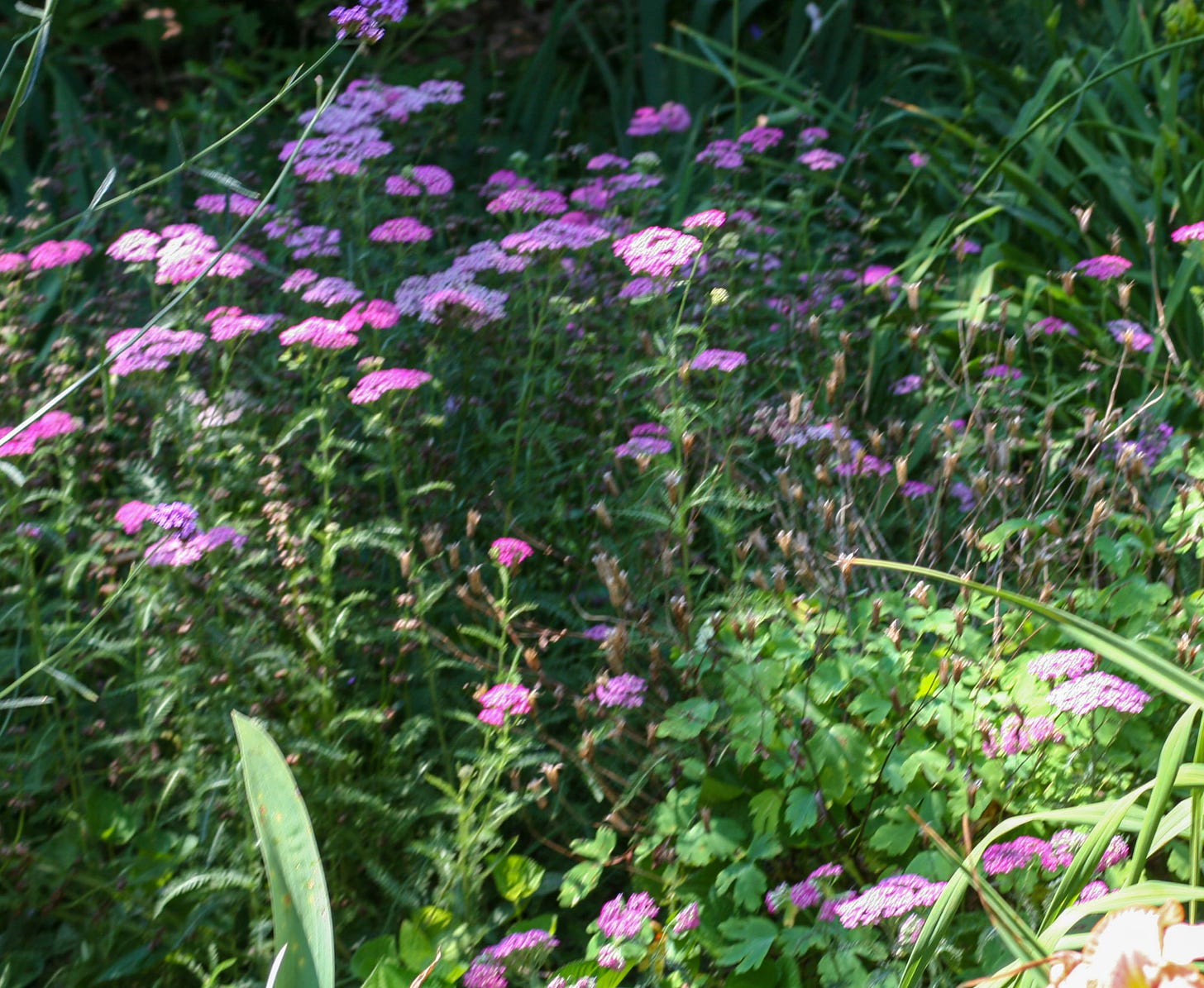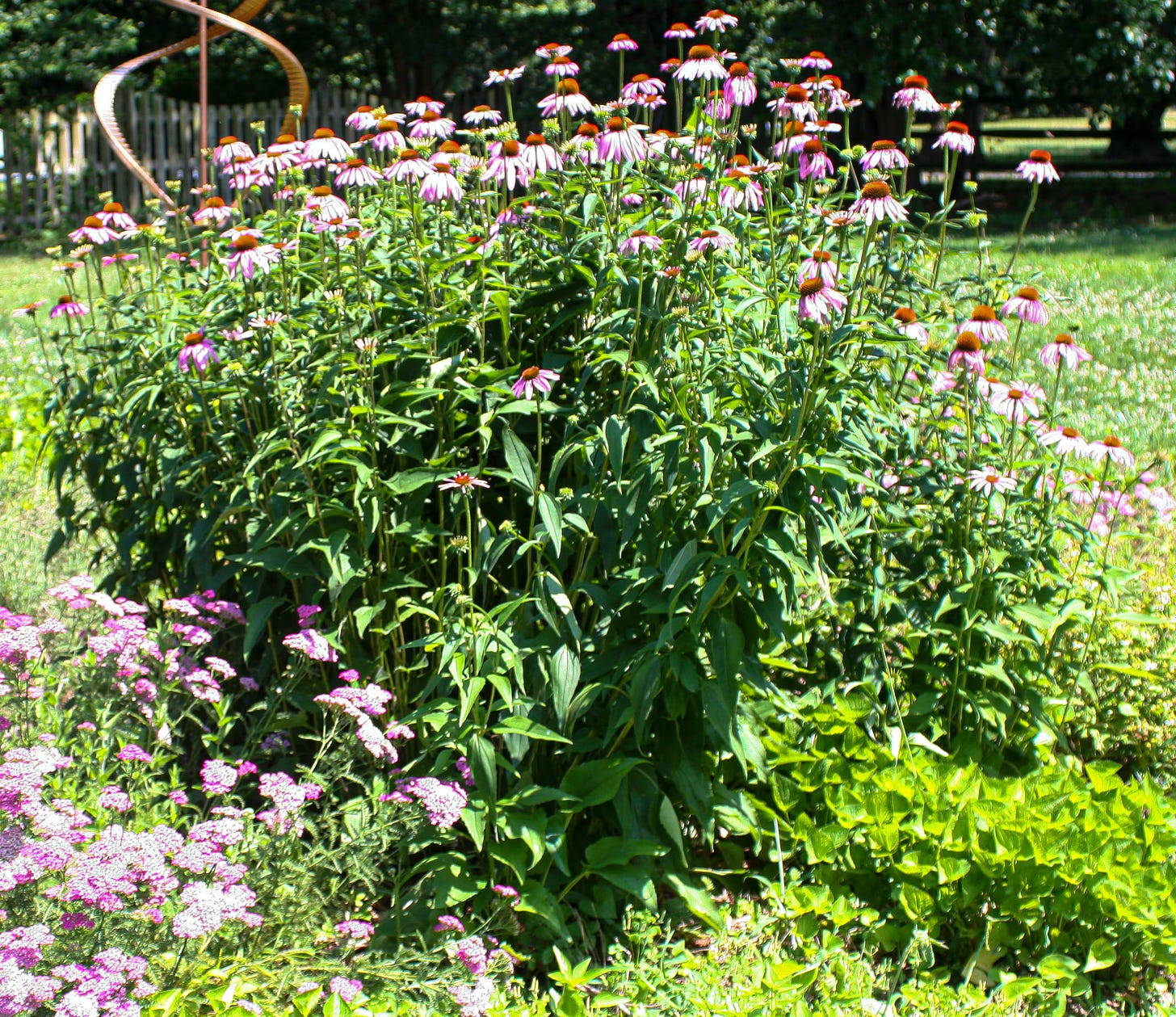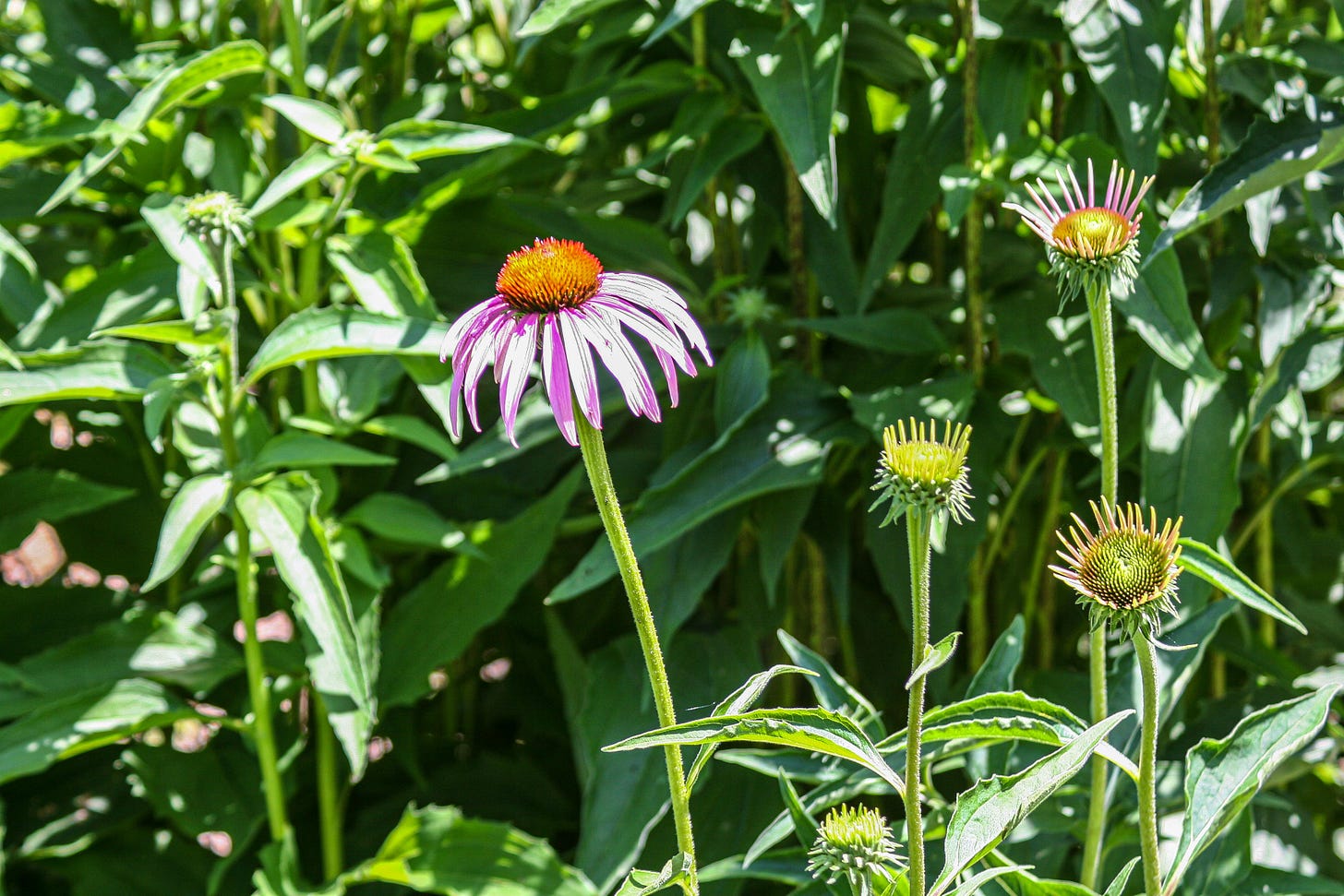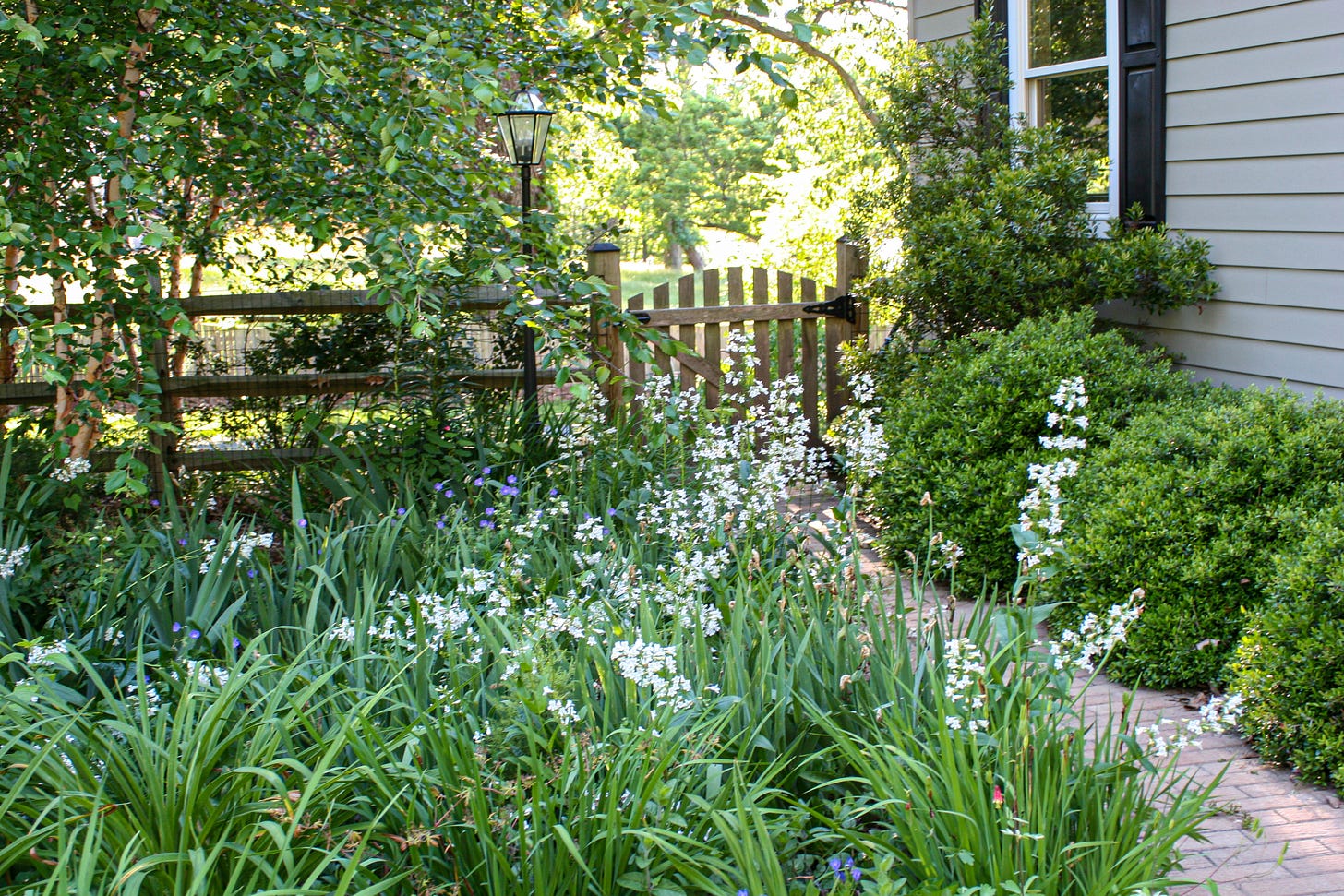The Joys of Living Mulch
The more you work with Living Mulch, the less you’ll want those fancy wood chips. It’s truly the way to go to reduce gardening chores, and it’s fabulous for ground bees and other denizens of the soil.
Living Mulch works quite brilliantly because plants are, for the most part, quite extroverted and love being surrounded by other plants, all snuggled up together. We can imagine what planty conversations they have in their close knit configurations.
“Can you even believe those crazy birds, they can’t even wait for the seeds to be finished before they eat them,” or “that dumb dog, I’d be so much bigger if only he’d find a different place to snooze,” or… what every gardener secretly dreads… “She/he’s killing those folks! She/he always pulls that wire grass, so glad it’s not me…this time…”
Planty conversations aside, Living Mulch accomplishes all sorts of great things for those who allow it, or those who live in it. (Coming Soon - Creating Living Mulch)

What is Living Mulch, anyway?
Living Mulch is using living plants to accomplish all the benefits of “regular” mulch. The big difference is that plants are planted closely together and allowed to grow as large as they’d like (or you’d like) instead of each plant standing lonely, isolated by piles of wood chips from any other.
I can just hear all the “you’re insane” thoughts aimed my way! I understand you can’t believe. Seriously. It took me a while to get over the shock myself. But I tried, and now I don’t do it any other way. I hate mulching and weeding chores.
For real - can mere plants, without lots of wood chips or grass clippings or compost, compete for excellence with the much ballyhooed mulch we’ve seen all our lives?
In fact, yes. Maybe it’s those planty conversations.
A friend, who’d just moved into her brand new home with all the horrific, compacted clay soil left by the busy builder, admired my soil when I dug some plants to share with her. She fretted that her new plants would die because her soil was so awful and good heavens, look at mine. Such deep, almost black, color. So wonderfully easy to dig, obviously rich and fabulous for the plants I was digging out for her. Surely her plants would die, her soil was beyond hope…

Patiently I explained (again). 3 years before, my soil looked just like hers, if not much worse. Our home was only 3 years old, we’d had the same ugly mess left by our builder. We used a 30 lb. digging bar to break the soil to plant in. —Yes, I pitied those plants, trying to live in what was essentially concrete.
But, a few years later, it was rich and black and utterly inviting to gardeners. Our secret? We made Earth Beds (see Making Earth Beds); we bravely planted all sorts of plants; then we more or less ignored it until she saw it. No extra mulch, no piles of compost, no fertilizer, nothing but the plants and only what remained of the mulch we applied to make an Earth Bed.
3 years after Earth Bed, utilizing only Living Mulch, resulted in jealous friends. It’s the way to go, particularly if you’re not in love with mulching and weeding chores. Let nature mulch for you! You’ll get happy plants and fabulous soil.
My friend took it on faith, and established several Earth Beds in her back yard. One year later, she is delighted with all the birds, who love the trees and shrubs she planted directly into the beds themselves. She’s now planting perennials all through the beds.
So, let’s take a good, hard look at Living Mulch.
Benefits of Mulch (any mulch!) in the Garden:
Adds organic matter to the soil.
Limits evaporation/retains moisture (up to 70% more moisture retained).
Keeps soil cooler in summer.
Protects plants from mud splash during heavy rains.
Helps prevent weeds.
Improves biological activity/soil conditions.
Can provide a home for plant-friendly insects.
That’s a big list, it’s why every knowledgeable gardener insists that mulch is the way to go. No questions asked! The only question is if plants alone can do the job for us. Let’s see.
Living Mulch does all this, and… more than all this, too. But, let’s look–
Adds organic matter to the soil. Of course Living Mulch does that. In fact, it does it better than conventional mulches, because the organic matter contains the nutrients the plants took out of the soil in the first place, so they are replenished continually without fertilizers, etc. No excess fertilizer to run off and pollute the waterways. Good news! In addition, since plants all grow their roots to different depths, pulling nutrients up from whatever depth they’ve hit, and, since their roots can touch each other, the mycorrhizae on their roots can share the nutrients amongst them all, improving the nutrient picture for all of them. Wood mulch, grass clippings, etc., add nutrients that those plants used. Not necessarily what your plants use. Living mulch puts back the nutrients your garden plants used.
Limits evaporation/retains moisture. Again, Living Mulch seems to do this better than conventional mulches. Conventional mulches can literally drain moisture out of the soil to replenish that which has evaporated. If that wasn’t bad enough, conventional mulches can and do prevent water from getting to the soil if they’ve dried out. Wood chips in particular dry out and rehydrate when water is available, so that if it’s only a small rain burst or responsible watering, you may in fact only be wetting the mulch. This can limit the evaporation from the soil, but it doesn’t provide more water to the plants themselves during their critical growing season. Living Mulch, by contrast, directs water into the soil, which absorbs it deeply.
Living Mulches, i.e. a whole bunch of plants snuggling together, allow water to enter the soil each time water is applied (while conventional mulches absorb a lot of water). Plants want the water in the soil! That’s where their roots are, and their roots are excellent for absorbing water. The canopy of leaves they create blocks much evaporation; the small amount which occurs is, for the most part, absorbed into the plants through the leaves (many people use gravel under houseplants to increase the humidity for the plants with happy results; in effect, you’re doing the same thing in your yard).
All that shade is also fabulous for preventing mud splash when it rains. The water falls onto leaves, not soil; water runs slowly off the leaves, which creates no mud splash at all.
Keeps soil cooler in summer. Living mulch is great at this, probably better than wood chips (leaves, particularly unshredded leaves, do a great job “moisturizing” the soil, too). Those plant leaves create shade. If you try this method of garden improvement, you’ll probably find toads (which eat mosquitos and other insects we don’t like) basking in the shade of your plants. Toads will die in the sun; they love the cooler, humid air under your plants. And they love mosquitoes! Yum.
Helps prevent weeds. Living Mulch is, hands down, more effective at preventing weeds than virtually all conventional mulches. Quite simply, the shade of the leaves prevents seeds from germinating; those that do struggle to find sunlight, limiting their growth (this can help with “volunteers” too). Some will pop their heads up no matter what mulch you use - plants can and do break through concrete - but Living Mulch saves so much weeding time it’s almost crazy. The “weeds” you’ll see are, after even just a few years, almost all “volunteers” of those you’ve planted or “volunteers” planted by squirrels, etc. Not a whole lot to worry about.
Improves biological activity/soil conditions. Plant roots start a community beneath the soil that create the very conditions that plants love. It’s a diverse community compared to the very limited community most mulches create; consider that all sorts of stuff is available to soil microbes from leaves, roots, mycorrhizae, toad droppings, etc. when plants are simply growing together compared to what is possible with simply rotting wood chips - which might not contain all the nutrients your plants want, and can easily rob your soil of nutrients as they decompose (like nitrogen)!
Can provide a home for garden friendly insects. Only a few mulches do this at all, but, as you’d guess, Living Mulch is stellar. Try it for a couple of years in at least one spot in your yard and you’ll notice fireflies (which are endangered, and need your kindness!). The more Living Mulch you have, the more fireflies you’ll see. As far as I can tell, it’s a direct relationship. And who doesn’t love those cute, harmless little insects, that eat snails and slugs in their larval state? Go ahead, cheer! Great as they grow up, fun when they’re grown-ups! Go, fireflies!
Then… Living Mulch is far better at preventing mosquitos than conventional mulches. Mosquitos can breed in mud, which means that if you actually manage to get enough water past your wood chips, mosquitos can happily breed in the mud, protected by the chips. With few to no toads to scarf them up, it’s likely you’ll suffer. Yoikes!
And to top it off - Living Mulch actually provides home for beleaguered bees. Ground bees (most bees live in the ground) struggle with heavy mulches, but they can find homes in the ground under the plants’ canopy. Many, if not most, plants “reserve” a small space encircling the roots for their own. Bees aren’t fooled. Bees see a nice, “empty” space (no mulch!!!) and dig in. They can’t lift heavy mulch, but Living Mulch provides many lovely spots for them to enjoy. Then they rush around pollinating all your tomatoes, cukes, and melons. Pumpkins. Whatever.
Living Mulch - GO FOR IT!!!!!!
Coming soon - “Creating Living Mulch” and “Roots - The Unsung Heroes”







